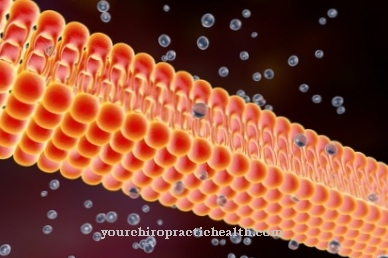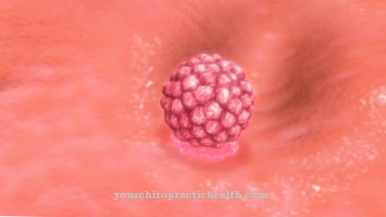As diastole This is the name given to the relaxation phase of the heart muscle, in which blood flows from the atria into the ventricles during the early filling phase with the leaflet valves open. In the subsequent late filling phase, further blood is actively transported into the chambers by contraction of the atria. In the systole that follows, the blood is pumped from the chambers into the circulatory and pulmonary circulation by contraction of the heart muscle.
What is the diastole?

The diastole, the relaxation and filling phase of the two heart chambers (ventricles), is followed by the systole, the tension, contraction and expulsion phase of the heart chambers. Diastole and systole together form a complete sequence of heartbeats that is (almost) regularly repeated.
The heart rhythm is shown in the chronological sequence of the contraction and relaxation phases of the heart muscles within a complete heartbeat sequence. In healthy people, it follows a certain pattern that can be measured using an electrocardiogram (EKG). The repetition rate per minute for people at rest is around 60 to 70 beats, depending on their physical fitness and age.
The two atria of the heart go through a comparable rhythm which is out of phase with the rhythm of the ventricles. During the diastole of the ventricles, the atria go through their systolic phase and vice versa. The diastole of the ventricles can be divided into three main phases. It begins with the relaxation phase immediately following the contraction phase. In the relaxation or relaxation phase, all 4 heart valves are briefly closed. During the subsequent early filling phase, the two leaflet valves that create the connection between the left atrium and the left ventricle, or the right atrium and the right ventricle, open. The blood flows from the atria into the chambers.
During the subsequent systole of the atria, a further amount of blood is actively pumped from the atria into the chambers.
Function & task
The necessary blood circulation is maintained by the heartbeat sequence with systole and diastole. Oxygen-rich blood from the pulmonary veins is pumped into the aorta, the large body artery, and oxygen-poor blood from the body veins into the pulmonary arteries.
The main phases of the chambers run almost parallel and are initiated electrically by the sinus node in the right atrium. The electrical contraction impulses reach the ventricular muscles via the AV node, the bundle of His and the Purkinje fibers, which react accordingly with the initiation of the systole.
Diastole and systole must practically be viewed as a unit, since they cannot take place independently of one another. The relaxation phase during diastole is the prerequisite for the subsequent contraction phase, because the heart muscle cells need a short time of about 100 milliseconds for their repolarization after the contraction phase, the prerequisite for receiving a new contraction pulse.
Diastole is responsible for filling the chambers with blood. To ensure that it is venous blood and not blood that the chambers have previously pumped into the large body artery, the aorta, and into the pulmonary artery, the two pocket valves, the pulmonary valve and the aortic valve must close and remain closed during the entire diastole stay.
Since the two pocket flaps function on the principle of a check valve, they close passively when the residual blood pressure in the arteries, the diastolic blood pressure, exceeds the pressure in the chambers. During the pressure build-up in the systolic phase, the blood pressure in the chambers exceeds the diastolic pressure in the arteries, allowing them to reopen and blood to be pumped into the arteries.
The heart rate can be adjusted according to the requirements of the body, especially the muscles, within a range of around 60 to a maximum of 200 beats per minute. However, because a disruption of the succession of diastole and systole can immediately become life-threatening, it has evolved so that the sequence of the heart rhythm is largely autonomous, with its own electrical stimulus generation including two replacement systems and its own stimulus transmission through modified heart muscle cells.
Illnesses & ailments
The arterial blood pressure is made up of the separate systolic and diastolic values. The normal values are around 80 mmHg (diastolic arterial blood pressure) to 120-140 mmHg (systolic arterial blood pressure). Deviations can arise due to a variable requirement profile with increased physical stress to which the cardiovascular system reacts.
The “residual pressure” in the arteries during diastole is mainly dependent on the factors physical demands, hormonal status, elasticity of the arterial vessel walls, thickness and elasticity of the ventricular muscles and the functionality of the pulmonary and aortic valves. The sequence of phases of the largely autonomously controlled heart rhythm can also have an influence on the diastolic blood pressure in the arteries.
The multitude of influencing factors already suggest that malfunctions in one or more organs that affect blood pressure and / or heart rate can lead to symptoms and complaints. One of the most common problems that occurs is irregular heartbeat, which leads to a type of dysfunction of the beat phases. The best known cardiac arrhythmia is the so-called atrial fibrillation, which is usually triggered by chronic high blood pressure.

Atrial fibrillation usually manifests itself in a permanently high pulse rate of around 150 beats per minute, whereby the atria can move the blood “in circles” in a completely disorderly manner, which is associated with considerable loss of performance and the risk of blood clots forming, which can trigger a stroke. In contrast to ventricular fibrillation, atrial fibrillation is not immediately life-threatening and can usually be treated with medication (beta blockers) and electrocardioversion (electric shock).



























